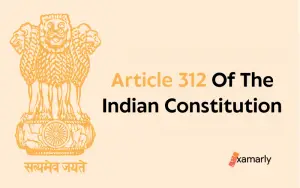The Air (Prevention and Control of Pollution) Act, of 1981 is an essential legislation enacted by the Indian government to prevent and control air pollution. With rapid industrialization and urbanization, air pollution has become a severe problem in India, causing significant health and environmental impacts.
The Act aims to regulate and monitor air quality, establish pollution control boards, and enforce measures to prevent and control air pollution.
In this blog, we will discuss the key provisions of the Air Prevention and Control of Pollution Act, 1981, and its impact on the environment and public health in India. We will also delve into the challenges faced in the implementation of the Act and possible solutions to overcome them.
This article provides detailed insights into the Air Pollution act 1981 which is an important topic for UPSC aspirants during their preparation.
- Air Pollution Act: Definitions
- Aims and Objectives of the Air Act, 1981
- Important Features of the Air Prevention and Control of Pollution Act
- Penalties and Procedure
- Conclusion
- FAQs on the Air Prevention and Control of Pollution Act, 1981
- What is the purpose of the Air Prevention and Control of Pollution Act, 1981?
- Who is responsible for enforcing the Air Prevention and Control of Pollution Act, 1981?
- What are the penalties for violating the Air Prevention and Control of Pollution Act, 1981?
- What is the role of the public in the implementation of the Air Prevention and Control of Pollution Act, 1981?
- How effective has the Air Prevention and Control of Pollution Act, 1981 been in reducing air pollution in India?
Air Pollution Act: Definitions
The Air Prevention and Control of Pollution Act, in Section 2, defines some key terms in order to understand the provisions of the Act better. The definitions are listed below:
- A liquid, solid or gaseous substance that can harm or injure nature and the surroundings, the humans and other living beings or plants living in it, or even any property of the land is classified as an “air pollutant” in Section 2(a). The noise was added to this register of compounds that are judged to be damaging to the environment by a 1987 amendment. As a result, noise pollution is likewise regulated under the Air Prevention and Control of Pollution Act 1981.
- According to Section 2(b), “air pollution” is identified by the existence of any air pollutant in the atmosphere.
- Under this Act, “approved fuel” refers to any fuel certified by the State Board.
- “Automobile” refers to any moving object set into motion by an internal combustion engine or another means that generates power from burning fuel.
- “Approved appliance” refers to any device that has been approved by the State Board for the requirements of this Act that is used to generate or consume any smoke, gas, or particulate matter.
- “Emission” is defined in Section 2(j) as any liquid, solid, or gas that leaves a chimney, duct, flue, or another outlet.
- “Board” refers to a State Board or the Central Board.
- Section 2(g) of this Act also established the Central Pollution Control Board (CPCB), which has jurisdiction over the entire nation. In order to implement the CPCB’s recommendations, the legislation also required the creation of State Pollution Control Boards (SPCB) for each of India’s states.
- The term “chimney” encompasses any building or framework that has an aperture or vent that can discharge air pollutants.
- “Control equipment” refers to any tool, machine, device, or system used to manage the quality and method of releasing any air contaminant. This can also be utilized to guarantee the effective functioning of an industrial facility.
- The term “industrial plant” refers to any facility utilized for industrial or commercial purposes and discharging any air pollutant into the air.
- The term “member” denotes an individual who is part of either the Central Board or a State Board, including the Chairperson of the respective board.
- The term “occupier” concerning any factory or land implies the person who has command over the operations of the factory or land. This also includes the individual who has possession of a substance associated with the premises.
- The term “prescribed” refers to what has been specified by regulations created by either the Central or State Government under this law.
- The term “State Board” refers to two different entities:
- The State Board in states where the Water (Prevention and Control of Pollution) Act of 1974 is active and a State Pollution Control Board has been established by the State Government under section 4 of that act.
- The State Board for the Prevention and Control of Air Pollution is established by the State Government under section 5 of this act in states where the other mentioned act is not active.
The Act sets standards for air pollution and regulates various types of pollutants. The goal is to eliminate air pollution and better the standard of the environment.
Aims and Objectives of the Air Act, 1981
The main purpose of the Air Prevention and Control of Pollution Act of 1981 is to control the level of air pollution. The Air Quality Control Board was set up to provide technical assistance to air pollution boards. It undertakes research and investigations on air pollution and advises the central government.
The agency also helps reduce air pollution through mass media, raises public awareness about pollution, and carries out other functions as directed by the air pollution act in India. The air pollution control board also sets air quality standards and maintains a laboratory.
Prime Objectives:
| 1. | To prevent air pollution by improving the quality and standard of the air. |
| 2. | To control air pollution by regulating industries causing air pollution |
| 3. | Preventing the emission of pollutants by industries into the atmosphere and abating them as necessary |
| 4. | To ensure that the environment and human life is protected from the adverse effects of air pollution |
| 5. | Reducing risk to public health from exposure to pollutants in ambient air quality |
Important Features of the Air Prevention and Control of Pollution Act
The Air Prevention and Control of Pollution Act 1981 has many features governed by the Central Pollution Control Board to protect the environment. This act helps its governing body tackle and prevent air pollution. Some of them are listed below:
- Section 3 of the Air Pollution Act of India states that State Pollution Control Boards and the Central Pollution Control Board (CPCB) should exercise their range of powers without prejudice.
- Section 4 states that if a state has already established a Water Pollution Control Board, then the same should be given joint responsibility and prescribed authority to monitor and control air pollution. The joint body should be called State Pollution Control Board.
- Section 5 addresses the concern of a state not having a Water Pollution Control Board. It states that in such a case a new pollution Control Board should be set up.
- Section 16 carries the duties of the Central Pollution Control Board. Some of them are listed below:
- Advising the Central Government and relevant authorities on matters related to air and air pollution
- Advising and supporting State Boards to carry out their functions for a healthy environment.
- Carrying out research related to air pollution.
- Spreading awareness about air and air pollution through mass media.
- Planning and organizing training of personnel for a safe environment.
- Setting the standards for the quality of air in India and emission limits in the industrial area to avoid excess emissions.
- Section 17 deals with the functions and comprehensive programs for the prevention of air pollution performed by State Pollution Control Boards. A few of them are listed below:
- Advising the State government on matters pertaining to air quality and air pollution.
- Planning and organizing training of personnel with the Central Pollution Control Board’s collaboration.
- Carrying out timely inspections in air pollution control areas.
- Researching if it is feasible to conduct industrial activity with respect to air pollution and advising the State Government on the same.
- According to Section 19, State Pollution Control Boards can exercise their authority of declaring any area as an Air Pollution Control Area. Consultation with CPCB is required.
- Section 21 puts forth that neither an individual nor an entity is eligible to establish an industry in an air pollution control area without prior permission.
- Section 22 asserts that no individual or entity is allowed to emit pollutants in the air above the set standards by the relevant Pollution Control Board. It also explains the authority of the board to ask a court to impose a restraining order on someone or something that is polluting the air.
- Section 26 provides special rights to officers of Boards for Pollution Control to carry out inspections and to take samples of the kinds of air pollutants from chimneys or ducts and test them for the existence of any dangerous pollutant.
- Section 28 allows the formation of new State Air Laboratories or declaring any existing lab as a State Air Lab by the relevant SPCBs. These labs are then provided with the authority to carry out air quality procedures and take air samples according to the standards of the relevant SPCB.
- Section 37 states that any person or entity who refuses to follow the rules and regulations of Section 21 and Section 22 will be seen as an offense punishable with an imprisonment of 12 months and 6 months respectively, but can be stretched to 6 years depending on type and intensity of the offense.
Penalties and Procedure
Penalties
Failure to follow the Central Pollution Control Board’s recommendations will result in one-year imprisonment. It can be prolonged to 6 years with an additional fee of 5000 rupees each day if the directives are not followed.
From Section 38 onwards, this air pollution control act mentions penalties for such offenses- which include:
- The public is not permitted to alter, move, remove, damage, or interfere with any object erected by or under the powers of the Board.
- Not providing the necessary data to a Board officer or staff.
- Damaging Board property.
- Lack of notifications about the release of more pollution than what is typical as established by the State Board. Notification of the likelihood of such a release should be provided to the State Board.
- Making a misleading statement when giving information to Board officials.
- Giving the Board of inquiry false information under Section 21 in order to get permission in order to raise an industrial plant.
Any command or direction that has no penalty as per the act, when disobeyed is punished by 3 months in prison or a fine of 3000 rupees or even both.
Section 40 addresses corporate offenses. Every person who has direct authority over a company, who was accountable to the firm for the way its business was conducted, along with the company itself, will be held accountable if it violates the law. He will be punished in line with the guidelines of this Act. However, if the crime was done without his knowledge or if he made all necessary preparations and measures to stop it, he or she will not be liable.
Section 40(2) also stipulates that if the offense was done with the approval of the director, the manager, the secretary, or any other officer, or if it occurred due to the aforesaid people’s negligence, they are found at fault and punishable.
Section 41 discusses offenses committed by government agencies. If a government department commits an offense as per the air Act 1981, the head of such a department may be prosecuted and punished appropriately. The Head of the Department will not be held liable, nevertheless, if he used due diligence to stop the offenses from happening or had no information that they were being committed.
Procedures
Procedures are discussed from section 42 to section 46. A court will only hear an environmental complaint if it is brought by one of the following parties:
- A CPCB-authorized officer.
- An individual who has filed a complaint with the board or a board officer. The complaint shall be filed no later than sixty days after the offense.
Conclusion
The Air Prevention and Control of Pollution Act of 1981’s primary goal is to reduce air pollution. The Air Act 1981 has fifty sections and makes arrangements regarding the formation of central and state boards to control pollution and the intensity of passage and decision-making.
The Air Prevention and Control of Pollution Act also prescribes punishments for violators and defines responsibilities for organizations and the Government. These sections provide important information for the public. It is important to understand all aspects of this act to ensure the protection of the environment.
FAQs on the Air Prevention and Control of Pollution Act, 1981
What is the purpose of the Air Prevention and Control of Pollution Act, 1981?
The primary objective of the Air Prevention and Control of Pollution Act, 1981 is to prevent and control air pollution in India. It provides regulatory mechanisms, guidelines, and pollution control boards to monitor and regulate air quality.
Who is responsible for enforcing the Air Prevention and Control of Pollution Act, 1981?
The central and state pollution control boards are responsible for enforcing the provisions of the Air Prevention and Control of Pollution Act, 1981.
What are the penalties for violating the Air Prevention and Control of Pollution Act, 1981?
Violations of the Act can result in fines and imprisonment for the offender. The penalty amount depends on the severity of the offense.
What is the role of the public in the implementation of the Air Prevention and Control of Pollution Act, 1981?
The public plays a crucial role in the implementation of the Act. It is their responsibility to follow the guidelines and regulations set forth by the Act, raise awareness about the dangers of air pollution, and report any violations.
How effective has the Air Prevention and Control of Pollution Act, 1981 been in reducing air pollution in India?
While the Act has helped to raise awareness and regulate industrial emissions, there are still significant challenges to be addressed. Air pollution remains a severe problem in India, and the Act requires stricter enforcement, greater public participation, and more comprehensive monitoring and reporting mechanisms to achieve its goals.






